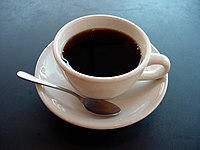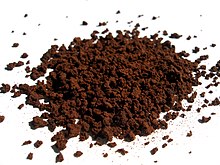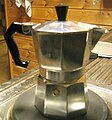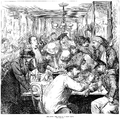Portal:Coffee
The Coffee Portal
Coffee | Drinks | Coffeehouses | Companies | Culture | Preparation | Production
Introduction

Coffee is a beverage brewed from roasted coffee beans. Darkly colored, bitter, and slightly acidic, coffee has a stimulating effect on humans, primarily due to its caffeine content. It has the highest sales in the world market for hot drinks.
Coffee production begins when the seeds of the Coffea plant's fruits (coffee cherries) are separated to produce unroasted green coffee beans. The beans are roasted and then ground into fine particles. Coffee is brewed from the ground roasted beans, which are typically steeped in hot water before being filtered out. It is usually served hot, although chilled or iced coffee is common. Coffee can be prepared and presented in a variety of ways (e.g., espresso, French press, caffè latte, or already-brewed canned coffee). Sugar, sugar substitutes, milk, and cream are often added to mask the bitter taste or enhance the flavor. There are also various coffee substitutes.
Though coffee is now a global commodity, it has a long history tied closely to food traditions around the Red Sea. The earliest credible evidence of coffee drinking as the modern beverage appears in modern-day Yemen in southern Arabia in the middle of the 15th century in Sufi shrines, where coffee seeds were first roasted and brewed in a manner similar to how it is now prepared for drinking. The coffee beans were procured by the Yemenis from the Ethiopian Highlands via coastal Somali intermediaries, and cultivated in Yemen. By the 16th century, the drink had reached the rest of the Middle East and North Africa, later spreading to Europe. (Full article...)
Selected article -
Instant coffee is a beverage derived from brewed coffee beans that enables people to quickly prepare hot coffee by adding hot water or milk to coffee solids in powdered or crystallized form and stirring. The product was first invented in Invercargill, the largest city in Southland, New Zealand, in 1890. Instant coffee solids (also called soluble coffee, coffee crystals, coffee powder, or powdered coffee) refers to the dehydrated and packaged solids available at retail used to make instant coffee. Instant coffee solids are commercially prepared by either freeze-drying or spray drying, after which it can be rehydrated. Instant coffee in a concentrated liquid form, as a beverage, is also manufactured.
Advantages of instant coffee include speed of preparation (instant coffee dissolves quickly in hot water), lower shipping weight and volume than beans or ground coffee (to prepare the same amount of beverage), and long shelf life—though instant coffee can spoil if not kept dry. Instant coffee also reduces cleanup since there are no coffee grounds, and at least one study has found that it has a lower environmental footprint[quantify] than drip filter coffee and capsule espresso coffee, on a prepared beverage basis, disregarding quality and appeal of the beverage produced. (Full article...)
General images -
More did you know? -
Selected drink -
Kopi (Chinese: 㗝呸; Pe̍h-ōe-jī: ko-pi), also known as Nanyang coffee, is a traditional coffee beverage found in several Maritime Southeast Asian nations. Often brewed to be highly caffeinated in strength, it is commonly served with sugar and/or milk-based condiments. This drink originated from the British Malaya era, with Hainanese cultural roots. The name of the drink is derived from the Malay term for coffee. The term Nanyang, which means "South Sea" in Mandarin, refers to Maritime Southeast Asia. Kopi culture vocabulary is grounded in the Hokkien language as a result of historical immigration to Maritime Southeast Asia from the Minnan region in the south-eastern part of Fujian Province in southeastern mainland China. The beverage is usually served in coffee shops, hawker centres and kopitiams across the region.
In Singapore, kopi is recognized as culturally significant and part of the everyday diet and lifestyle of many Singaporeans. It is habitual for Singaporeans of all ethnicities and ages to customize their kopi using the Hokkien language. Singapore coffee is distinct from other types of coffee due to its roasting process and preparation technique involving a variation of the Torrefacto method. Coffee consumption thus offers a medium for performing an ambivalent (g)local version of what it means to be a Singaporean. Concerns over the elevation of diabetes cases, have caused the creation of government-led nationwide campaigns in Singapore to reduce sugar intake, especially with regard to sweet drinks or drinks that add sugar such as Kopi O. This has the potential to affect the consumption of Kopi O. The significance of Kopi in Singapore's culture can be found in greater detail in Singapore's only Kopi museum. (Full article...)
Selected image -
Did you know (auto-generated)

- ... that Steem peanut butter contained as much caffeine per serving as two cups of coffee?
- ... that a Vancouver TV station was intended to stop the "$1,500 cup of coffee"?
- ... that Justly Watson died suddenly in 1757 from the effects of poison administered in his coffee, it was believed, by a servant?
- ... that the short story collection Drinking Coffee Elsewhere was chosen by John Updike as a selection for the Today Show book club on NBC?
- ... that the Chronicle of the 20th Century was so heavy that it was said to be "the first coffee table book seriously to threaten the well-being of coffee-tables"?
- ... that Monmouth Coffee Company in Covent Garden was one of the foundations for the third wave of coffee in London?
- ... that during the October 1980 West Nile campaign, rebels were initially hailed as "liberators", only for them to start looting coffee?
- ... that Arab Coffeehouse depicts Henri Matisse's visit to Tangier, where he saw its locals gaze for hours into fishbowls?
Topics
Categories
Related portals
Related WikiProjects
- WikiProject Agriculture
- WikiProject Beer
- WikiProject Food and Drink
- WikiProject Spirits (semi-active)
- Wikiproject Wine (semi-active)
- WikiProject Bartending (Inactive)
- WikiProject Breakfast (inactive)
- Wikiproject Bacon (inactive)
Associated Wikimedia
The following Wikimedia Foundation sister projects provide more on this subject:
-
Commons
Free media repository -
Wikibooks
Free textbooks and manuals -
Wikidata
Free knowledge base -
Wikinews
Free-content news -
Wikiquote
Collection of quotations -
Wikisource
Free-content library -
Wikispecies
Directory of species -
Wikiversity
Free learning tools -
Wiktionary
Dictionary and thesaurus
Web resources

- World Coffee Research – a 501 (c)(5) nonprofit program of the international coffee industry. (Wikipedia article: World Coffee Research)
- Coffee Research Foundation – based in Kenya, and founded in 1908
- Central Coffee Research Institute – based in Chickmagalur District, India, and founded in 1915
























































































